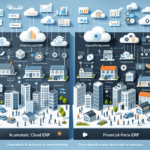Acumatica Cloud ERP vs Sage Intacct: An In-Depth Comparison
Choosing the right cloud-based ERP software is crucial for businesses aiming to streamline operations, enhance efficiency, and drive growth. Acumatica Cloud ERP and Sage Intacct are two of the leading solutions in the market, each offering robust features tailored to different business needs. This comprehensive comparison explores various aspects of both systems to help you make an informed decision.
Understanding Cloud ERP Software
Cloud ERP systems have revolutionized the way businesses manage their operations by offering flexibility, accessibility, and cost-effectiveness. Unlike traditional on-premise ERP solutions, cloud-based ERPs are hosted on remote servers and accessed via the internet.
Benefits of Cloud ERP
- Accessibility: Access data from anywhere with an internet connection, facilitating remote work and global operations.
- Scalability: Easily scale resources up or down based on business requirements without significant infrastructure changes.
- Automatic Updates: Receive regular updates and new features without manual installation, ensuring the system remains current and secure.
- Cost-Effectiveness: Reduce upfront costs by eliminating the need for expensive hardware and maintenance.
- Data Security: Benefit from advanced security measures implemented by cloud providers, including encryption and regular security audits.
- Disaster Recovery: Enhanced disaster recovery options with data backups and quick restoration capabilities.
According to a Gartner report, the global public cloud services market is expected to grow by 17% in 2023, highlighting the increasing adoption of cloud solutions like ERP systems.
Key Features of Acumatica Cloud ERP
Acumatica Cloud ERP is renowned for its flexibility and comprehensive feature set tailored to various industries. Key features include:
Financial Management
- General Ledger
- Accounts Payable and Receivable
- Cash Management
- Budgeting and Forecasting
Distribution Management
- Inventory Control
- Order Management
- Warehouse Management
Customer Relationship Management (CRM)
- Sales Automation
- Marketing Campaigns
- Customer Support
Project Accounting
- Project Costing
- Resource Management
- Time and Expense Tracking
Mobile Accessibility
The Acumatica mobile app allows users to access the ERP system from smartphones and tablets, supporting features like barcode scanning and photo attachments for real-time data entry in the field.
Key Features of Sage Intacct
Sage Intacct is a cloud-based ERP solution particularly strong in financial management and suited for medium to large enterprises. Its standout features include:
Financial Management
- Advanced General Ledger
- Accounts Payable and Receivable
- Cash Management
- Revenue Recognition
Advanced Reporting and Analytics
Sage Intacct offers robust reporting tools with customizable dashboards and real-time analytics, enabling businesses to make data-driven decisions.
Project Accounting
- Project Budgeting
- Expense Tracking
- Time Management
Multi-Entity and Global Consolidations
Supports complex organizational structures with features for managing multiple entities, locations, and currencies, making it ideal for global businesses.
Integrations
Sage Intacct integrates seamlessly with various third-party applications, including CRM systems like Salesforce, payment gateways, and HR management tools.
Pricing Models Comparison
Understanding the pricing structures of Acumatica Cloud ERP and Sage Intacct is essential for budgeting and financial planning.
Acumatica Cloud ERP Pricing
Acumatica offers a flexible pricing model based on the number of users, required modules, and storage needs. This approach allows businesses to tailor their ERP investment according to their specific requirements. Typically, Acumatica is more affordable for small to medium-sized businesses.
Sage Intacct Pricing
Sage Intacct's pricing is also modular but tends to be higher compared to Acumatica, reflecting its focus on medium to large enterprises with more complex needs. Pricing is based on the number of users and selected modules, with additional costs for advanced features and integrations.
Cost Comparison
For small businesses, Acumatica often provides a more cost-effective solution due to its scalable pricing. Larger corporations may prefer Sage Intacct for its advanced financial features and scalability, despite the higher cost.
Both providers offer free trials and demos, allowing businesses to evaluate the software before committing.
Ease of Use and User Interface
The user experience plays a significant role in ERP adoption and effectiveness. Both Acumatica and Sage Intacct are designed with user-friendly interfaces, but they have distinct differences.
Acumatica Cloud ERP UI
Acumatica features a modern, intuitive interface that is highly customizable. Users can tailor dashboards and workflows to match their specific business processes, enhancing usability and efficiency.
Sage Intacct UI
Sage Intacct offers a clean and straightforward interface with customizable dashboards that provide a quick overview of key metrics. While user-friendly, it offers less flexibility in UI customization compared to Acumatica.
Training and Support
Acumatica provides extensive training resources, including online tutorials, user guides, and a vibrant community forum. Sage Intacct also offers comprehensive support, including a knowledge base and community forums, but may provide more personalized support options for enterprise clients.
Support and Customer Service
Effective support is crucial for resolving issues and ensuring smooth ERP operations.
Acumatica Cloud ERP Support
- 24/7 phone and email support
- Comprehensive documentation and user community
- Rapid response times for critical issues
Sage Intacct Support
- Dedicated account managers for enterprise clients
- Phone and email support with quick response times
- Extensive knowledge base and community forums
Both systems are highly rated for customer satisfaction. Acumatica has been recognized by G2 Crowd for exceptional customer support, while Sage Intacct has received accolades from the Stevie Awards for its customer service.
Performance and Scalability
Performance and scalability are critical factors for ERP systems, especially for growing businesses.
Acumatica Cloud ERP Performance
Acumatica utilizes a centralized database architecture, ensuring data consistency and high performance. Its cloud infrastructure supports rapid scaling to accommodate business growth without performance degradation.
Sage Intacct Performance
Sage Intacct is optimized for high transaction volumes and complex financial operations. Its cloud architecture allows for seamless scalability, making it suitable for large enterprises with extensive data processing needs.
Both systems offer robust performance, but Sage Intacct may have an edge in handling more complex financial transactions and larger datasets.
Integration Capabilities
Integrating ERP with other business tools is essential for creating a cohesive technology ecosystem.
Acumatica Cloud ERP Integrations
Acumatica supports integrations with a wide range of third-party applications, including:
Sage Intacct Integrations
Sage Intacct offers extensive integration options, including:
Both ERP systems provide robust integration capabilities, but the specific needs of your business may determine which platform offers more relevant integrations.
Security and Data Protection
Data security is paramount for any ERP system, given the sensitive information they handle.
Acumatica Cloud ERP Security
- Two-factor authentication
- Role-based access controls
- Data encryption in transit and at rest
- Regular security audits and compliance with industry standards
Sage Intacct Security
- Data encryption and secure socket layer (SSL) protocols
- Advanced firewalls and intrusion detection systems
- Role-based permissions and access controls
- Compliance with SOC 1, SOC 2, and other industry standards
Both Acumatica and Sage Intacct implement rigorous security measures to protect user data, ensuring compliance with global security standards.
Customization and Flexibility
Every business has unique requirements, and the ability to customize an ERP system can significantly impact its effectiveness.
Acumatica Cloud ERP Customization
- Customizable user interfaces and dashboards
- Flexible workflows and automation
- API access for custom integrations and extensions
- Modular architecture allowing selective feature implementation
Sage Intacct Customization
- Customizable dashboards and reports
- Automation through workflows and business rules
- APIs and SDKs for integrating custom applications
- Ability to add custom fields and objects to existing modules
While both systems offer extensive customization options, Acumatica's open architecture may provide more flexibility for businesses needing highly tailored solutions.
Industry-Specific Functionality
Different industries have unique operational needs, and selecting an ERP system that caters to these can enhance efficiency and compliance.
Acumatica Cloud ERP for Various Industries
Acumatica provides specialized features for industries such as:
- Construction
- Distribution
- Retail
- Healthcare
- Manufacturing
Sage Intacct for Targeted Industries
Sage Intacct offers industry-specific modules for:
- Non-Profit Organizations
- Financial Services
- Franchise Operations
- Hospitality
Selecting an ERP that aligns with your industry can provide built-in functionalities that address sector-specific challenges and regulatory requirements.
Implementation Process and Timeframe
Efficient implementation is critical to minimizing disruption and ensuring a smooth transition to a new ERP system.
Acumatica Cloud ERP Implementation
The implementation process for Acumatica typically spans 3-6 months, depending on the complexity and size of the business. It involves phases such as:
- Requirement Analysis
- System Configuration
- Data Migration
- Training and Testing
- Go-Live and Support
Sage Intacct Implementation
Sage Intacct is known for its efficient implementation methodology, often enabling businesses to go live within 30 days. The process includes:
- Project Planning
- System Setup
- Data Import
- User Training
- Deployment and Ongoing Support
The faster implementation timeline of Sage Intacct can be advantageous for businesses looking to expedite their ERP adoption.
User Reviews and Testimonials
Feedback from users provides valuable insights into the real-world performance and support of ERP systems.
Acumatica Cloud ERP Reviews
Users praise Acumatica for its flexibility, ease of use, and responsive customer support. It is often highlighted for its ability to adapt to evolving business needs and its comprehensive feature set.
Sage Intacct Reviews
Sage Intacct receives positive reviews for its robust financial management capabilities, advanced reporting, and scalability. Users also appreciate the dedicated support and the system's ability to handle complex financial operations.
Both platforms boast high satisfaction rates, making them reliable choices depending on your specific business requirements.
Conclusion: Choosing the Right Cloud ERP for Your Business
Both Acumatica Cloud ERP and Sage Intacct offer powerful tools to manage and optimize business operations. Your choice should depend on factors such as:
- Business Size and Complexity: Acumatica is ideal for small to medium-sized businesses seeking flexibility, while Sage Intacct caters to medium to large enterprises with complex financial needs.
- Industry Requirements: Choose an ERP that offers industry-specific functionalities relevant to your sector.
- Budget: Acumatica generally presents a more cost-effective solution for smaller businesses, whereas Sage Intacct's advanced features justify its higher price for larger organizations.
- Implementation Timeline: If rapid deployment is a priority, Sage Intacct's streamlined implementation process may be advantageous.
- Customization Needs: Acumatica's open architecture provides greater customization opportunities for businesses with unique processes.
Ultimately, both Acumatica Cloud ERP and Sage Intacct are robust, scalable solutions that can significantly enhance your business operations. Carefully assess your business needs, budget, and long-term goals to select the ERP system that aligns best with your objectives.






















